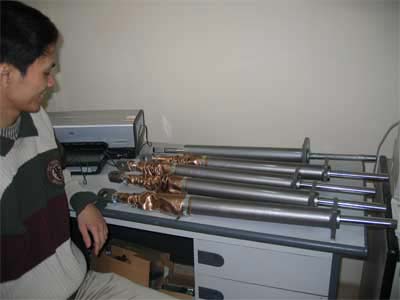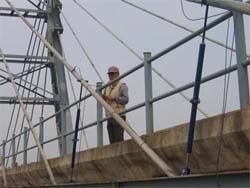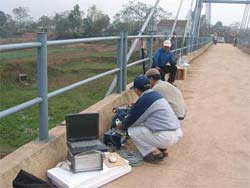To support the construction of cable-stayed bridges designed by Vietnam in the future, experts from the Institute of Mechanics (Vietnam Academy of Science and Technology) have successfully developed and tested a vibration damping device for this type of bridge.
 |
Vibration damping devices (energy dissipation) for the cables of cable-stayed bridges |
Previously, vibration damping devices had to be installed for each cable of cable-stayed bridges such as My Thuan Bridge and Bai Chay Bridge. Currently, all cable-stayed bridges being constructed in Vietnam are using imported vibration damping devices.
Recently, experts from the Structural Mechanics Department at the Institute of Mechanics, in collaboration with the Institute of Mechanical Research, Ministry of Industry, have developed a vibration damping device for suspension bridges. The device has been evaluated for quality on the dynamic system of the Institute of Construction Science and Technology.
After a period of laboratory research, in collaboration with traffic science experts, the device has been experimentally applied at the Ben Coc cable-stayed bridge (Ha Tay) and Ngoi Lan bridge (Yen Bai).
At Ben Coc Bridge, 16 devices were installed on 16 cables, and a convoy of trucks weighing 12 tons each passed over the bridge. The results showed that with the device in place, the vibrations of the cables were significantly reduced and could be observed with the naked eye. In contrast, for the cables without the device, the vibrations had a considerable amplitude, which could lead to fatigue and cracking over time.
According to Professor Dr. Nguyen Dong Anh, the head of the research team and Chairman of the Science and Technology Council, the vibration damping device for suspension cables is similar to a motorcycle shock absorber, consisting of a cylinder containing a piston and high-viscosity silicone oil. When the cable or the bridge vibrates, the piston moves within the viscous medium, creating resistance to dissipate the vibration energy.
While the fabrication of the vibration damping device is not difficult, the crucial aspect is designing the device with resistance appropriate for each bridge and each cable on the bridge. To achieve this, the research team developed the SAVA (Structural Anti Vibration Analysis) software to analyze the vibrations of the structure equipped with the vibration energy dissipation device.
After inputting the parameters of the bridge and the damping device, SAVA evaluates the device’s effectiveness and adjusts the parameters of the device to minimize vibrations optimally. This software is also open for other applications such as vibration analysis for high-rise buildings, marine structures, etc.
According to Dr. Tran Viet Hung, head of the Scientific Research and Technology Development Program for Machine Manufacturing – KC.05, the technology for reducing harmful vibrations in construction projects is one that Vietnam can achieve, reducing costs associated with importing foreign equipment. If invested in and developed, Vietnam will quickly adopt a new global technology, drawing lessons to apply this technology in other fields such as high-rise buildings, high-speed trains, and marine structures.
|
|
|
|
|
|
Minh Son
























































